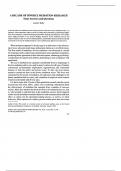zyxwv
zyxwvut
A DECADE OF DIVORCE MEDIATION RESEARCH
Some Answers and Questions
zyxwvutsrqponmlkji
zyxwvut zyxwvutsrqp
Joan B. Kelly
A decade of divorce mediation research has focused on outcomes such as settlement rates, cost
eflciency, client satisfaction, effect on levels of conflict and cooperation, psychological adjust-
ment, and compliance. Despite methodologicalproblems limiting generalizations, most siudies
report mildly favorable to very positive findings. Research on the mediation process and
mediator behaviors has received very limited aitention, and should be thefocus of the next decade
of research to elevate the mediation field to a more sophisticated, effective level of practice.
When mediation appeared 2 decades ago as an alternative to the adversar-
ial process, advocates made many enthusiastic claims as to its effectiveness.
The first model of mediation, divorce mediation, was advanced as a model
for reducing conflict, improving communication and coparental cooperation,
producing better agreements in less time and expense, enhancing psychologi-
cal adjustment for parents and children, and leading to more compliance with
agreements.
The use of mediation has expanded considerably from its beginnings in
divorce mediation and is now used in many locations for all types of family,
commercial, environmental, employment, organizational, and community
zyxwvu
disputes in both the public and private sector. To date, the most intense
research scrutiny has been in the divorce mediation sector. This focus was
stimulated by the novelty of mediation, the opposition and challenges to the
family mediation field by critics, and a tradition of empirical social science
research in the family and divorce area.
It is fair to state, after 12 years of first-generation research, that the easiest
research has been done. Basic, useful, even comforting, information about
zyxwv
the effectiveness of mediation has emerged from a number of outcome
studies. Much less attention has been devoted to the mediation process, that
is, what actually is said and done in the mediation session. Such empirical
studies record and analyze mediator behaviors and communications and their
effect on clients and the agreement-making process, as well as on client
behaviors. More expensive to conduct, process studies most often have been
Author’s Note: This article is a revised version of a keynote uddress given at the Second
International Mediation Conference in Adelaide, Australia, January 1996.
FAMILY AND CONCILIATION COURTS REVIEW, Vol. 34 No. 3, July 1996 373-385
0 1996 Sage Publications,Inc.
373
, 374 zyxwvutsrqponm
zyxwvutsrqp
FAMILY AND CONCILIATION COURTS REVIEW
conducted in experimental social psychology settings with controlled vari-
ables and scripted client roles.
This article briefly summarizes what has been learned to date about
divorce and custody mediation, and suggests areas of inquiry that should be
the focus of empirical research in the next decade. Although the overall
number of studies have been limited, research has helped to advance the field
and its general acceptance to this point. There are still many challenging
issues to address if mediation is to mature further as a field and take its place
zyxwv
among the major service interventions offered to clients in need.
OUTCOME RESEARCH
zyxwvutsrqpo
The most common research questions thus far have been the following:
zyxwvutsrqp
1. Is mediation an effective means of reaching agreement?
2. Does it save time and money?
3. Are the agreements reached any different in mediation as compared to the
adversarial settlement?
4. Does mediation lead to more compliance and less relitigation?
5 . How do clients evaluate the mediation process and outcomes?
6. Is conflictreduced and interparentalcooperationenhanced through mediation,
compared to litigated or attorney-negotiatedsettlements?
7. Does mediation enhance the psychological adjustment of the parties and their
children?
8. For whom is mediation appropriate? Who should be included or excluded,
and on what basis?
The vast majority of the divorce mediation outcome research in England,
Canada, and the United States has focused on child custody mediation. Addi-
tionally, in Australia, England, and the United States, research has assessed
comprehensive divorce mediation encompassing property division, spousal
and child support, and custody and access issues. Regardless of focus, very
few studies have compared mediation processes with their counterparts in
the adversarial system. Nevertheless, this overall data base from four coun-
tries provides some answers to the above questions.
It is important to note that variations in research populations, methodolo-
gies, and measures have been the norm, making it problematic to generalize
about mediation or rely heavily on a single study. Complicating our task is
the fact that some research publications fail to provide basic descriptors that
might enable us to understand outcome differences, such as the nature of the
population served, the number of sessions and hours of service provided, the
model (if any) used by mediators, how directive or therapeutic the mediators’




